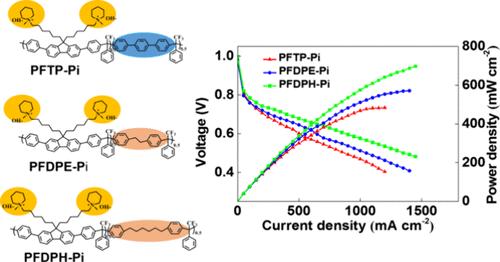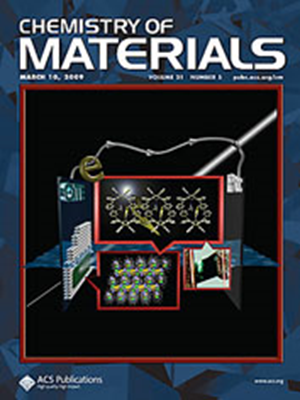Poly(fluorene-co-alkyl)-based Polymers Bearing Pendant Piperidinium Cations for Alkaline Anion Exchange Membrane Fuel Cell Applications
IF 7.2
2区 材料科学
Q2 CHEMISTRY, PHYSICAL
引用次数: 0
Abstract
A series of ether-free poly(fluorene-co-alkyl) bearing pendant piperidinium cations (PFDPE-Pi and PFDPH-Pi) was synthesized by introducing alkyl spacers into the main chain. For comparison, quaternized poly(fluorene-co-triphenyl) without alkyl spacers was prepared and characterized under the same conditions. The introduction of flexible alkyl spacers imparted excellent flexibility, high water uptake, and high conductivity to the PFDPE-Pi and PFDPH-Pi membranes. Notably, the conductivity of PFDPH-Pi decreased by only 4% after immersion in 2 M KOH at 80 °C for 30 days, indicating its excellent alkaline stability. The H2/O2 anion exchange membrane fuel cell with PFDPH-Pi exhibited a peak power density of 698 mW cm–2, which was significantly higher than that of 484 mW cm–2 observed for the cells with PFTP-Pi. This study provides an effective approach for preparing durable polyfluorene-based anion exchange membranes with satisfactory comprehensive performance, highlighting their potential for fuel cell applications.

求助全文
约1分钟内获得全文
求助全文
来源期刊

Chemistry of Materials
工程技术-材料科学:综合
CiteScore
14.10
自引率
5.80%
发文量
929
审稿时长
1.5 months
期刊介绍:
The journal Chemistry of Materials focuses on publishing original research at the intersection of materials science and chemistry. The studies published in the journal involve chemistry as a prominent component and explore topics such as the design, synthesis, characterization, processing, understanding, and application of functional or potentially functional materials. The journal covers various areas of interest, including inorganic and organic solid-state chemistry, nanomaterials, biomaterials, thin films and polymers, and composite/hybrid materials. The journal particularly seeks papers that highlight the creation or development of innovative materials with novel optical, electrical, magnetic, catalytic, or mechanical properties. It is essential that manuscripts on these topics have a primary focus on the chemistry of materials and represent a significant advancement compared to prior research. Before external reviews are sought, submitted manuscripts undergo a review process by a minimum of two editors to ensure their appropriateness for the journal and the presence of sufficient evidence of a significant advance that will be of broad interest to the materials chemistry community.
 求助内容:
求助内容: 应助结果提醒方式:
应助结果提醒方式:


